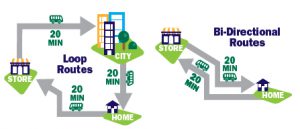
Greenlink – the public transit system serving Greenville County, SC – could see the first significant improvements to its routes in decades if recommendations from its recent Comprehensive Operational Analysis are implemented.
This Comprehensive Operational Analysis, or COA for short, was a product of the Piedmont Health Foundation’s 2015 study of public transit and health and human services transportation. The study found a strong need for improved mobility in the community but revealed that most residents – both riders and nonriders – perceived Greenlink’s services to be insufficient. Part of that was due to limited service times and geographic coverage constrained by Greenlink’s low levels of funding.
But frankly, part of this insufficiency was tied to outdated routes and stops. The transit system had been designed decades earlier and many routes had never been updated. Yet Greenlink staff and board members weren’t certain of the best way to go about making changes because of limited data with which to make decisions. There was no data on which stops were most and least used so that routes could be redesigned to meet the needs of today’s riders. Without solid business information, Greenlink couldn’t take the first steps to become the system of the future.
So our study in 2015 recommended that first step – in the transit world, a study called a Comprehensive Operational Analysis, or COA for short. The goal of the COA was to identify strengths of the system and areas for improvement and to provide suggestions to improve efficiency and increase ridership without any additional revenues. With funding support from the City of Greenville, County of Greenville, and Piedmont Health Foundation, Greenlink hired Connetics Transportation Group of Atlanta to conduct the COA.
The COA had three major findings:
First, Greenlink accomplishes a lot with a little. It uses its limited resources more efficiently than its peers based on its low cost per peak vehicle, cost per revenue hour and cost per revenue mile. Research we released earlier this year showed that Greenlink receives far less local funding in absolute terms and per capita than its peer systems in the Southeast. This finding from the COA shows it is using every one of those dollars well.
Second, because the recommendations were restricted to the assumption that no new revenues would be available for improvements, the best way to improve service would be to make routes bi-directional where possible, meaning the bus services both sides of the road, rather than loop routes. This would be a significant change in Greenville County, as many of Greenlink’s routes are loops or non-linear shapes. More on this below.
Third, Greenlink’s maintenance facility is too small to adequately serve the system. Staff and board members have known that the maintenance facility, which was formerly a beer distributorship located on Augusta Street near the Greenville Drive stadium, was insufficient to service an aging fleet of vehicles, but the COA provided clear documentation of the facility’s constraints on the system.
Regarding the route changes: the proposed changes aim to continue offering coverage to as many current riders as possible, but in a way that is far more efficient. Click here to see the proposals in detail. The changes reduce the service area footprint by 6.9%, but only 2.4% of existing Greenlink riders are using existing stops in the areas losing service. However, all of these changes are just proposals. Greenlink will begin a month-long process of hearing from the public: What do they like? What are their concerns? What changes to the recommended routes would they make? The Board will then consider all of this feedback and make final decisions to go into effect in the summer of 2018. Click here to see a full schedule of public hearings.
GTA Board and Greenlink staff are excited about the future and ready to make informed improvements to the system. We’ve previously reported that Greenlink staff are up to the task.
As GTA board chair Addy Matney said, “We know our customers and potential customers want better service. Identifying and implementing these positive short-term, revenue neutral changes are important first steps toward building a more vibrant transit system for our community.”
But doing so will take partners, something Greenlink welcomes. Transit Director Gary Shepard said, “Greenlink is excited that nonprofit organizations, such as Piedmont Health Foundation, and the business community are beginning to talk about the need for improved transit. Greenlink will be unable to make the needed changes without support from the community, and we greatly appreciate the partnerships that have developed.” Interested in learning more? Contact Nicole McAden, Marketing and Public Affairs Specialist at Greenlink, or Katy Smith, Executive Director of Piedmont Health Foundation, or sign up for a transit field trip.
To learn more:
